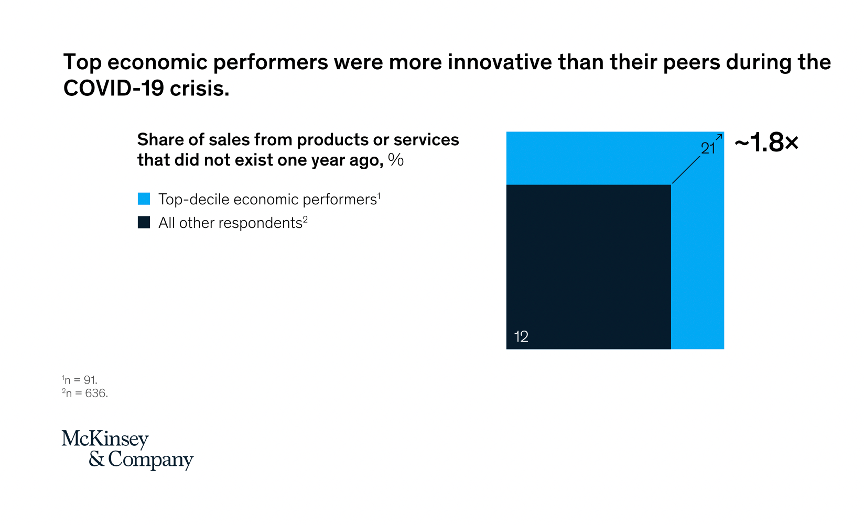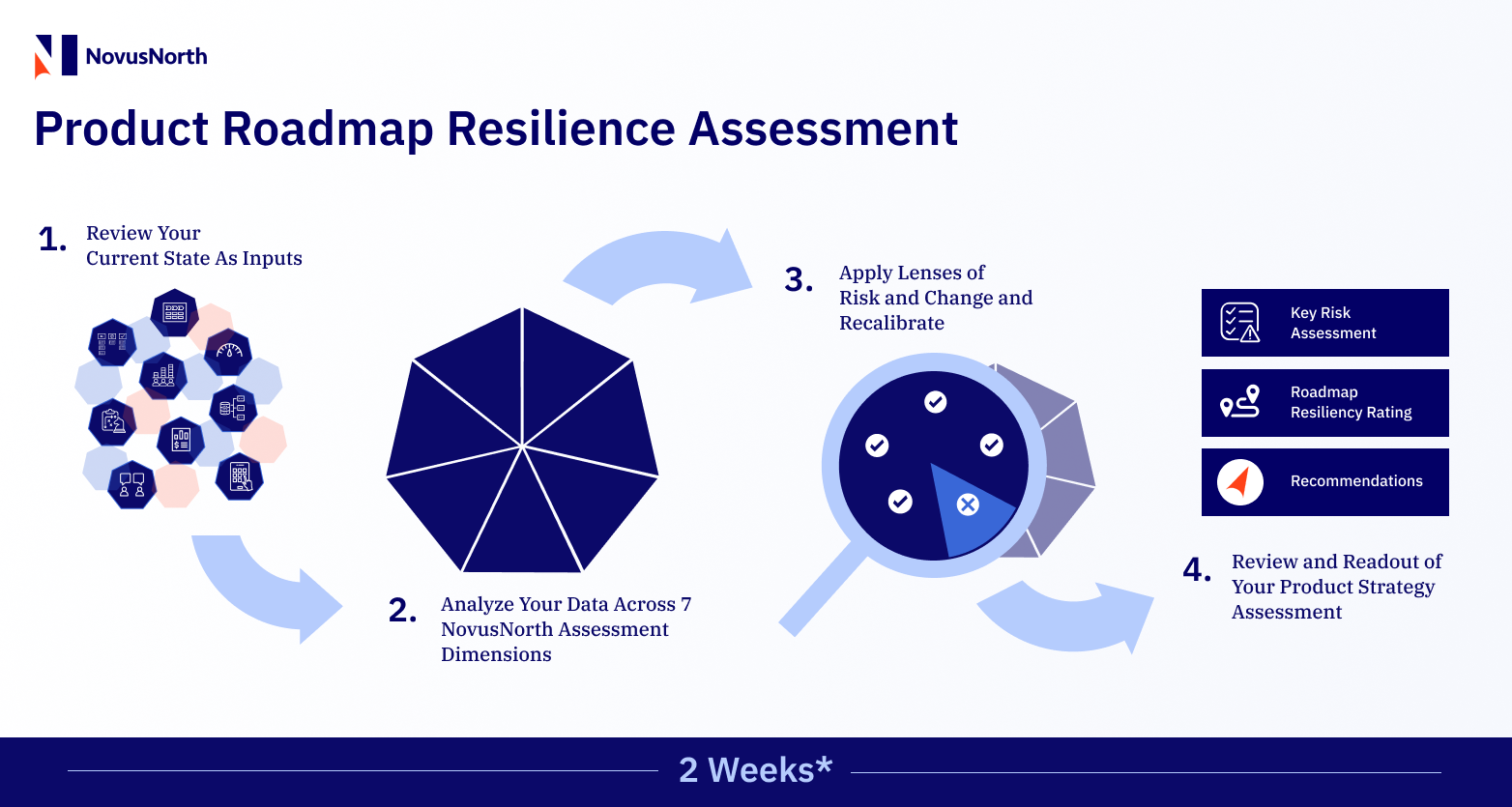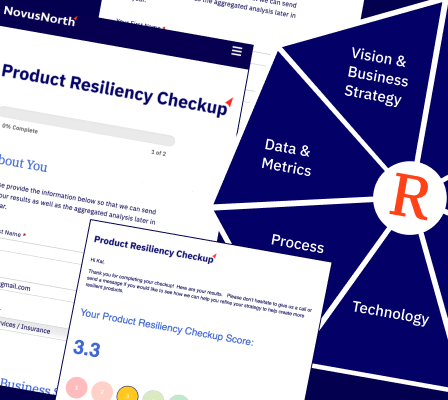The current environment of post pandemic fallout, volatile markets, rising interest rates and heated global political conditions have put incredible pressures on firms. Numerous digital product launches have been cancelled, scaled back or abandoned. Capital budgets across many Fortune 500 firms have suddenly become frozen or slashed due to the market stutter steps. Start-ups are scrambling to stay afloat in many cases. Is your product roadmap prepared to weather the storm?
Now is the time to take a hard look at your product roadmap. Most firms operate with a messy hybrid of agile and lean methodologies with some expectation of achieving speed to market with measurement baked in. The reality is that few realize these benefits and instead are left with monolithic programs that often over-run budgets and under-deliver on customer and internal expectations. Many firms have over-engineered incremental redesigns of their existing business models, products, and platforms. Instead, a more revolutionary approach should be taken to focus on true innovative creation vs evolution.
McKinsey’s newest global survey on digital strategy shares how leading performers have capitalized on more revolutionary strategies, “…bolder, at-scale investments in technology are significantly more likely to support a successful transformation than those that are smaller in scope.” The diagram below further supports this.

Recommendations For Leading Through A Downturn lists being ‘Bold’ as the number two recommendation. “During a recession, you have three choices for how to make decisions: 1) hold on to the past, 2) respond when required, or 3) get in front of the wave. The first two options keep you locked into the past, while the third option allows you to start looking ahead.”
What Are The Top Risks and Roadblocks to Your Strategy and Product Roadmap?
So how exactly can firms create a bolder, more revolutionary strategy and ensure product roadmaps are created to be able to deliver with speed and success? We can see where things may go wrong by taking a look at a case study. A notable top US bank tried launching a digital bank a few years ago only to shutter it within a year of launch. A lack of differentiating features from the core traditional bank and reliance upon existing legacy back-end infrastructure were the primary problems. A more aggressive and incremental strategy here may have been more successful.
These are the top roadblocks we see our clients facing with their product roadmaps that limit the potential of their product strategies:

Inability to Effectively Prioritize
You are trying to do too much, appeasing too many stakeholders. See Dave’s blog that introduces the concept of Defining your Minimum Measurable Product (MMP) vs a Minimum Viable Product. Balancing your product management and development processes for both agility and scale is tricky to ensure your product strategy stays resilient, differentiated, relevant and feasible. Employing product innovation sprints (not to be confused with pure design or development sprints) led by the right experts can help guide more rapid, successful, and consistent prioritization.

Pressure to Leverage Legacy Assets
Leveraging legacy assets often results in achieving very little and watering down new product ideas and features. Start-ups and smaller firms benefit here if they can create the right partnerships to achieve speed to market while keeping true to their product vision. A revisit to the early 2000’s may be needed where large companies spun off separately funded and managed entities to truly innovate and build. It is our experience that the #1 impediment to innovation and speed to market is executive stakeholder alignment across legacy institutions for product groups tasked with creation of new products and service

Not Having The Right Talent
This can be for either or both for creation and innovation as well as execution. One client who leads Product Management for a top 5 financial services firm stated “We are good at defining discrete product opportunities in a timely fashion-like finding pots of gold, and we send lots of lean teams to go get them but we are spread too thin”. Finding the ‘just right vendor’, likely not a monolith and not a freelancer, something in between that can partner with your team to scale in the best way to augment your weaknesses and optimize your team’s time. Boutique teams of experts will help to bring fresh ideas and broad experience that often is not found within legacy teams.

Matrixed Ownership and Lack of Accountability
This often manifests itself with independent product, design, IT and operational divisions that report very high in the organization. While well intentioned, KPIs often drift from top-level business/product goals into micro-goals that then wag the proverbial dog. Creating smaller/cross functional teams with tighter alignment, integrated goals and top level sponsorship will help speed to delivery and reduce product dilution. Alternatively, selecting a set of capability that cuts across fewer organizational boundaries for initial releases can improve odds for success and build much needed momentum for future releases.
Do You Need to Evaluate Your Product Strategy?
If you are wondering if you need to have a bolder strategy or need help ‘pressure testing’ your product roadmap to ensure it is resilient to withstand upcoming change, here are some questions to ask yourself:
- Has your team been able to launch products/releases on time?
- Have these projects been measured in months, not years?
- Have you gained measurable success (increased market share/revenues) with these recent launches?
- Are you a market leader in your category/region?
- Have you had to adjust your product strategy or budget?
- How are capital funds currently being allocated?
- Do you have the talent you need to innovate and deliver?
Pressure Testing Your Product Roadmap
Our team of experts can quickly help you assess and re-invent your product roadmap in time for your next budget and planning cycle using our proprietary and proven NovusNorth methodology. This product strategy framework utilizes 7 key domains which helps us to assess and create new and differentiated product roadmaps in as little as 2 weeks. In this framework, we look at everything from audience and design to technology and client-facing processes to look at how your product strategy can quickly react to external factors, and identify areas that need improvement to increase the resiliency of your product roadmap.

About The Authors

Michelle Palomera
Chief Growth Officer, NovusNorth
With an extensive career in design, technology and consulting for 30 years, Michelle has helped global firms develop and create market-leading and award-winning digital products and customer experiences. A former leader in several start-ups and public firms herself, Michelle has also led various acquisition, integration and strategic partnership initiatives.
The current environment of post pandemic fallout, volatile markets, rising interest rates and heated global political conditions have put incredible pressures on firms. Numerous digital product launches have been cancelled, scaled back or abandoned. Capital budgets across many Fortune 500 firms have suddenly become frozen or slashed due to the market stutter steps. Start-ups are scrambling to stay afloat in many cases. Is your product roadmap prepared to weather the storm?
Now is the time to take a hard look at your product roadmap. Most firms operate with a messy hybrid of agile and lean methodologies with some expectation of achieving speed to market with measurement baked in. The reality is that few realize these benefits and instead are left with monolithic programs that often over-run budgets and under-deliver on customer and internal expectations. Many firms have over-engineered incremental redesigns of their existing business models, products, and platforms. Instead, a more revolutionary approach should be taken to focus on true innovative creation vs evolution.
McKinsey’s newest global survey on digital strategy shares how leading performers have capitalized on more revolutionary strategies, “…bolder, at-scale investments in technology are significantly more likely to support a successful transformation than those that are smaller in scope.” The diagram below further supports this.

Recommendations For Leading Through A Downturn lists being ‘Bold’ as the number two recommendation. “During a recession, you have three choices for how to make decisions: 1) hold on to the past, 2) respond when required, or 3) get in front of the wave. The first two options keep you locked into the past, while the third option allows you to start looking ahead.”
What Are The Top Risks and Roadblocks to Your Strategy and Product Roadmap?
So how exactly can firms create a bolder, more revolutionary strategy and ensure product roadmaps are created to be able to deliver with speed and success? We can see where things may go wrong by taking a look at a case study. A notable top US bank tried launching a digital bank a few years ago only to shutter it within a year of launch. A lack of differentiating features from the core traditional bank and reliance upon existing legacy back-end infrastructure were the primary problems. A more aggressive and incremental strategy here may have been more successful.
These are the top roadblocks we see our clients facing with their product roadmaps that limit the potential of their product strategies:

Inability to Effectively Prioritize
You are trying to do too much, appeasing too many stakeholders. See Dave’s blog that introduces the concept of Defining your Minimum Measurable Product (MMP) vs a Minimum Viable Product. Balancing your product management and development processes for both agility and scale is tricky to ensure your product strategy stays resilient, differentiated, relevant and feasible. Employing product innovation sprints (not to be confused with pure design or development sprints) led by the right experts can help guide more rapid, successful, and consistent prioritization.

Pressure to Leverage Legacy Assets
Leveraging legacy assets often results in achieving very little and watering down new product ideas and features. Start-ups and smaller firms benefit here if they can create the right partnerships to achieve speed to market while keeping true to their product vision. A revisit to the early 2000’s may be needed where large companies spun off separately funded and managed entities to truly innovate and build. It is our experience that the #1 impediment to innovation and speed to market is executive stakeholder alignment across legacy institutions for product groups tasked with creation of new products and service

Not Having The Right Talent
This can be for either or both for creation and innovation as well as execution. One client who leads Product Management for a top 5 financial services firm stated “We are good at defining discrete product opportunities in a timely fashion-like finding pots of gold, and we send lots of lean teams to go get them but we are spread too thin”. Finding the ‘just right vendor’, likely not a monolith and not a freelancer, something in between that can partner with your team to scale in the best way to augment your weaknesses and optimize your team’s time. Boutique teams of experts will help to bring fresh ideas and broad experience that often is not found within legacy teams.

Matrixed Ownership and Lack of Accountability
This often manifests itself with independent product, design, IT and operational divisions that report very high in the organization. While well intentioned, KPIs often drift from top-level business/product goals into micro-goals that then wag the proverbial dog. Creating smaller/cross functional teams with tighter alignment, integrated goals and top level sponsorship will help speed to delivery and reduce product dilution. Alternatively, selecting a set of capability that cuts across fewer organizational boundaries for initial releases can improve odds for success and build much needed momentum for future releases.
Do You Need to Evaluate Your Product Strategy?
If you are wondering if you need to have a bolder strategy or need help ‘pressure testing’ your product roadmap to ensure it is resilient to withstand upcoming change, here are some questions to ask yourself:
- Has your team been able to launch products/releases on time?
- Have these projects been measured in months, not years?
- Have you gained measurable success (increased market share/revenues) with these recent launches?
- Are you a market leader in your category/region?
- Have you had to adjust your product strategy or budget?
- How are capital funds currently being allocated?
- Do you have the talent you need to innovate and deliver?
Pressure Testing Your Product Roadmap
Our team of experts can quickly help you assess and re-invent your product roadmap in time for your next budget and planning cycle using our proprietary and proven NovusNorth methodology. This product strategy framework utilizes 7 key domains which helps us to assess and create new and differentiated product roadmaps in as little as 2 weeks. In this framework, we look at everything from audience and design to technology and client-facing processes to look at how your product strategy can quickly react to external factors, and identify areas that need improvement to increase the resiliency of your product roadmap.

About The Authors

Michelle Palomera
Chief Growth Officer, NovusNorth
With an extensive career in design, technology and consulting for 30 years, Michelle has helped global firms develop and create market-leading and award-winning digital products and customer experiences. A former leader in several start-ups and public firms herself, Michelle has also led various acquisition, integration and strategic partnership initiatives.
Our Latest Insights
Founder and CEO, Rich Cancro, shares how AdvisorEngine applies their guiding principles of Personal, Scientific and Beautiful to create a world-class wealth management platform for Registered Independent Advisors.
By NovusNorth
Good design is about more than how a digital application works; it’s about driving meaningful outcomes. Listen in to our conversation with Bob Troyer on how design creates meaningful differentiation for product leaders, how companies are approaching it, and what tips he has for maximizing results.
By NovusNorth
Voice AI provides a new modality for delivering customer experiences. Listen in to our conversation with Jason Fields on what’s going on with Voice today, how companies are using it and what tips he has for those just getting started.
By NovusNorth




